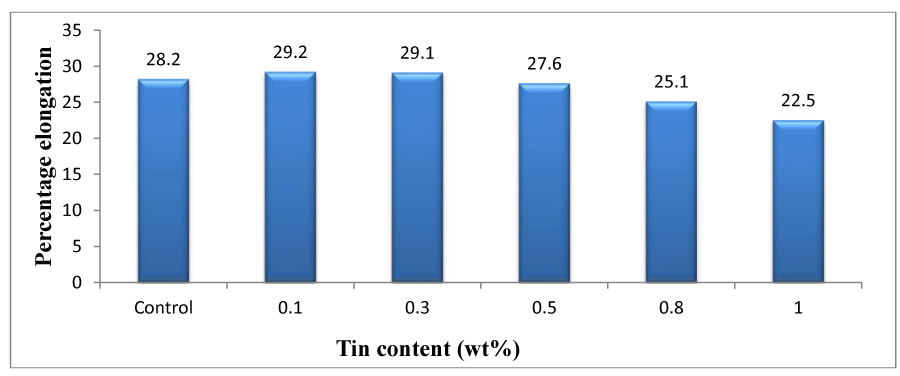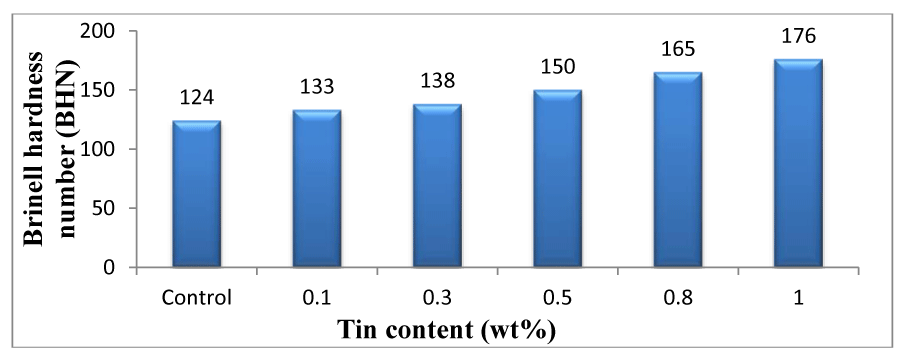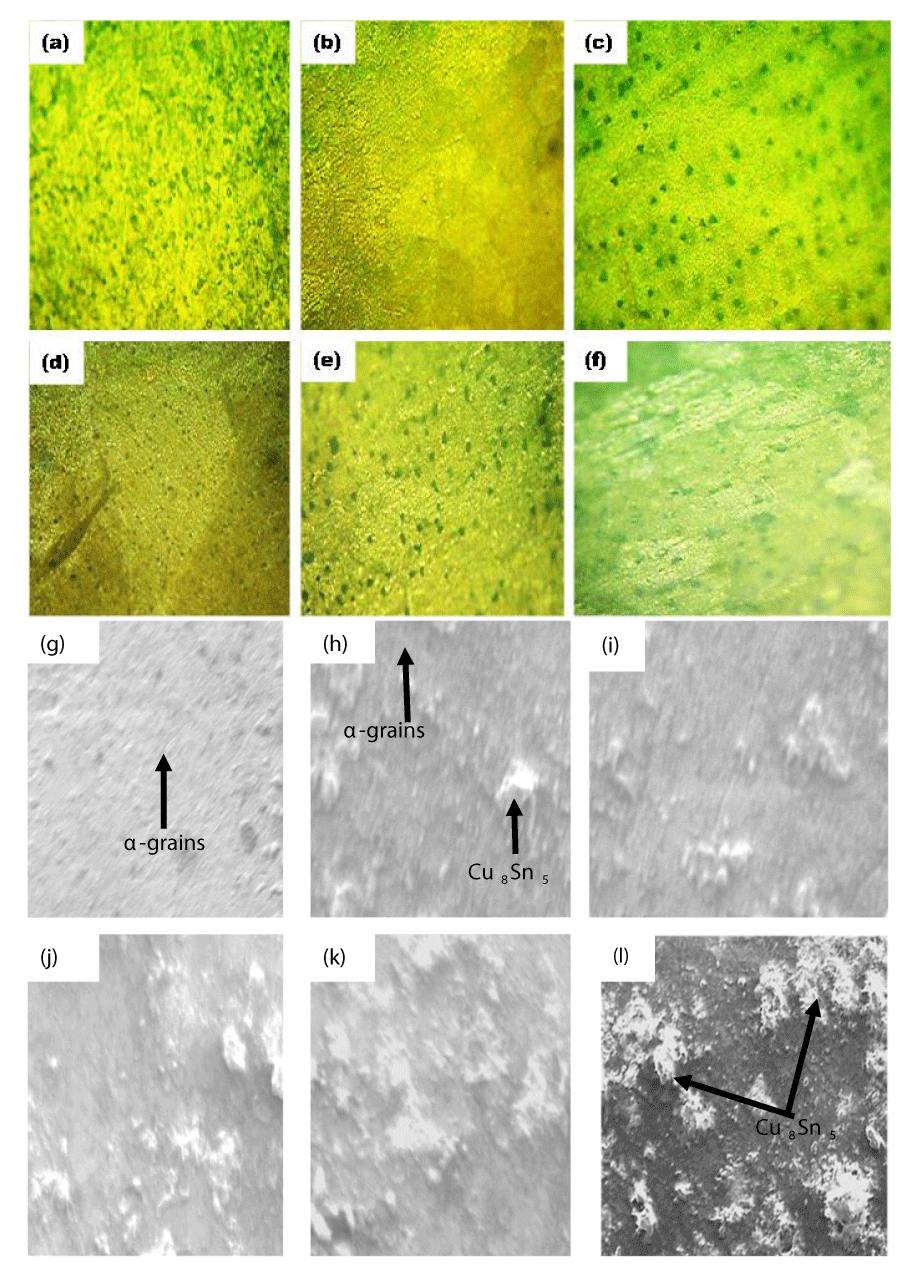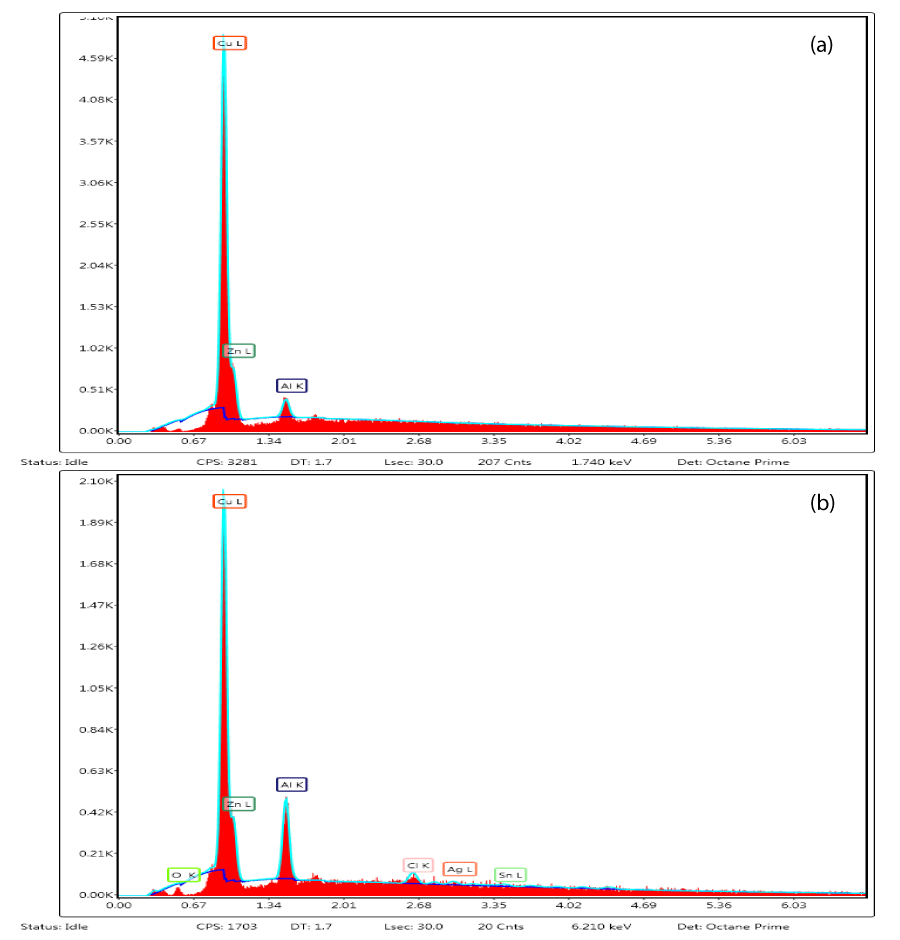International Journal of Nanomaterials, Nanotechnology and Nanomedicine
Insight into the microstructure and mechanical properties of Cu-20wt%Zn-xSn ternary alloy
Ifeanacho U Okeke, Kingsley C Nnakwo* and Eugene E Nnuka
Cite this as
Okeke IU, Nnakwo KC, Nnuka EE (2024) Insight into the microstructure and mechanical properties of Cu-20wt%Zn-xSn ternary alloy. Int J Nanomater Nanotechnol Nanomed 10(1): 008-011. DOI: 10.17352/2455-3492.000056Copyright License
© 2024 Okeke IU, et. al. This is an open-access article distributed under the terms of the Creative Commons Attribution License, which permits unrestricted use, distribution, and reproduction in any medium, provided the original author and source are credited.The main objective of this research is to study the grain refinement and improved trend in mechanical properties of brass (Cu-20wt%Zn) doped with tin. Tin was added in concentrations of (x: 0.1, 0.3, 0.5, 0.8, and 1wt%). The alloy samples were produced by permanent die casting and machined to the required dimensions for the structural analysis and mechanical tests. Mechanical properties studied were percentage elongation, ultimate tensile strength, and Brinell hardness using a 100KN JPL tensile strength tester (Model: 130812) and portable dynamic hardness testing machine (Model: DHT-6) respectively. The structural analysis was conducted using an optical metallurgical microscope (Model: L2003A) and scanning electron microscopy (SEM) equipped with EDS. The results of the structural analysis showed that the control specimen consisted predominantly of coarse α-phase of zinc in copper (Cu3Zn). The samples doped with tin consisted of refined α-grains with patches of the second phase (Cu8Sn5). Mechanical test results indicated that the addition of tin to alpha brass improved the ultimate tensile strength and hardness with a slight decline in percentage elongation. The values recorded for ultimate tensile strength and Brinell hardness were 322MPa and 176HB respectively.
Introduction
Copper remained a widely used metal renowned for its high electrical conductivity. The quest for an excellent combination of ductility, strength, hardness, electrical, and thermal conductivities makes copper alloys outstanding for a wide range of applications [1-3]. These properties are bestowed when copper is alloyed with other elements in specific quantities for a variety of purposes. It has been established over the years that some elements form a binary system with copper; zinc and tin being predominant [3,4]. Brasses have been distinguished from other alloys of copper due to their corrosion resistance, and high thermal and electrical conductivities. The name of the alloys was also derived from the alloying elements of brass ie silicon brass, leaded brass, tin brass, etc. Some alloying elements form intermetallic compounds in the structure of brass and alter the proportion of alpha, beta, or gamma phases [5-7]. This strengthening effect and improved mechanical properties were attributed to a reduction in grain size, modulus effects, and interfacial or surface energy [7,8].
Earlier research shows that an aluminum and titanium addition has an influence on the microstructure and mechanical properties of leaded brass and indicates structural modification and improved mechanical properties. Metastable phases of Cu2ZnTi and CuZnTi were revealed in Cu-40Zn alloy with a yield strength and ultimate tensile strength of 345MPa and 597MPa respectively [9,10]. The effect of the addition of tin, manganese, and silicon to brass shows enhanced structure, and improved mechanical properties and aids machining chip formation. It was found that the addition of tin together with silicon to Cu-40Zn alloy increased the amount of beta (β) phase and more uniform dispersive gamma (γ) phase. In the case of 60Cu-0.5Si-39.5Zn brass a hardness value of 123.4HV, Cu-38Zn-xFe3.3Sn alloy with improved hardness from 95HV-175HV.while Cu-40Zn-CrFe0.6Sn recorded 35%, 158HV, 300MPa, and 600MPa for ductility, hardness, yield, and ultimate tensile strength respectively [11-16]. The main objective of this research is to develop alpha brass of medium zinc content with enhanced microstructure and improved UTS and hardness in addition. The studied brass can serve as an alternative to tin bronze because of its cost-effectiveness and can be used in electrical terminals, automotive coolers, heat exchangers, plugs, lamp fittings, locks, ship-forging products, tubes, valves, decorative hardware, and architecture.
Methodology
The materials used for the experimental study were copper wire, zinc granules, and tin powder of percentage purity of 99.4%, 99.5%, and 98.9% respectively. The copper wire is reddish brown in color with a gauge thickness of 6 mm, zinc of silver gray amorphous granule with size 3 mm – 5 mm, and tin silvery rough powder with a thickness of 30 μm - 60 μm. The quantities of these materials were determined using weight percent calculation and measured using an electronic compact scale (Model: BL20001). For the control sample (Cu-20wt%Zn), 404 g of copper was charged into the preheated (700 0C) bailout crucible furnace and heated until melting was achieved slightly above 1083 0C. Thereafter, 105 g of pure zinc granule was introduced into the melt and stirred to achieve homogeneity. Extra 4g of copper and 5 g of zinc were added to compensate for percentage oxidation losses during heating. The mixture was stirred for 15 seconds to achieve a complete dissolution of the zinc metal. The prepared permanent mold was preheated at a temperature of 200 0C. The melt was poured into the preheated permanent mold and allowed to cool to ambient temperature. The Cu-20wt%Zn-xSn were developed by repeating the same procedure with tin addition in concentrations of 0.1, 0.3, 0.5, 0.8, and 1.0wt%. The tensile test samples were machined to 120 mm in length and 10 mm in diameter with a gauge diameter and length of 8 mm and 50 mm respectively. A tensile load of 100KN was applied to the specimen as the jaws separated apart until the test specimen fractured. The length of the samples before and after fracture was recorded. The load force and extension at the point of fracture were read directly from the indicator scale at the control system and recorded. The UTS was calculated from σ = Pmax/A0 where σ is UTS, P is the maximum load, A0 is the cross-sectional area of the samples, and %E calculated from L2-L1/L1 x 100 where L1 is the original length, L2 is final length. The hardness samples were machined to 20 mm in length and 16mm in diameter. The result was recorded after a load capacity of 612.9N with a 2.5 mm ball diameter for 15 seconds. The surface morphology of the developed Cu-20wt%Zn-xSn alloys was analyzed using an Optical Metallurgical Microscope (OM) and Scanning Electron Microscopy (SEM) equipped with EDS. Prior to the analysis, the sample surfaces were ground with emery paper of different grit sizes, polished with pure aluminum powder to a mirror surface, and etched in iron III chloride solution, HCl, and water. The samples for SEM were positioned and scanned and the energy peaks emitted by each constituent element were recorded.
Discussion
Tables 1,2 show the chemical composition and the mechanical test results of alpha brass (Cu–20Zn) with tin addition. Table 1 revealed that there are other impurity elements found in the doped alloy in minor fractions. These were contained in the compositional content of tin powder produced by the manufacturer and may have an effect on the results. Figures 1-3 show the variations in percentage elongation, ultimate tensile strength, and hardness of Cu–20Zn–xSn. The Standard Deviation (STD) of each of the mechanical test results was calculated using σ = √∑(X- x)2/N. The standard deviation values for %E, UTS, and Brinell hardness were ± 2.4, ± 56.65, and ± 18.15 respectively. The experimental results showed that the percentage elongation, ultimate tensile strength, and hardness of the parent alloy were 28.2%, 164MPa, and 124BHN respectively. The percentage elongation of the parent alloy increased by 3.5% after a trace addition of 0.1wt% tin with a corresponding decline as tin content increased. The increase in %E is discontinued as tin goes into solution with copper forming a second phase (Cu8Sn5). The addition of tin to as low as 0.1wt% increased the ultimate tensile strength and hardness of the control sample by 9.1% and 7.2%respectively. It is obvious from the micrographs in Figures 4b-4f that the addition of tin refined the grain morphology of the parent alloy, leading to an improvement in UTS and hardness to 322MPa and 176HB respectively. The values obtained from this study were in the range of values obtained by Nnakwo, et al. 2017; Cu-10Sn-1.0Ni alloy with UTS of 300MPa, Haruhiko, et al .2010; Cu-40Zn-CrFe0.6Sn recorded 35%, 158HV, and 600MPa for ductility, hardness, and ultimate tensile strength, Sasiworada et al., 2013; 60Cu-0.5Si-39.5Zn with a hardness value of 123.4HV, Moustafa, et al. 2016; Cu-38Zn-xFe3.3Sn alloy with hardness 95HV-175HV. Figures 4e-4l also shows that informed solid solubility with copper dispersed as the second phase. These improvements can also be linked with the decrease in the grain size and IMC formed at grain boundaries creating more barriers to dislocation movement. The EDS of the Cu-20Zn alloy contains aluminum as the only impurity while Cu-20wt%Zn-xSn has other impurities (Al, Ag, Cl) in minor quantities (Figure 5a,b). As tin concentration increased the volume of the second phase (Cu8Sn5) in the alloy increased.
Conclusion
Insight into the microstructure and mechanical properties of Cu-20wt%Zn-xSn ternary alloy in addition have been investigated using standard engineering techniques. The XRD elemental composition showed the inclusion of other impurities other than tin. The structure of the control sample primarily consists of the α-phase (Cu3Zn) of zinc in a copper matrix. The structure of Cu-20wt%-xSn showed refined precipitates of α-phase with patches of the second phase (Cu8Sn5) dispersed in the alloy matrix. The second phase (Cu8Sn5) precipitates increased in the alloy matrix as the concentration of tin increased. The ultimate tensile strength and hardness of the investigated alloy increased with an increase in the concentration of tin while %E showed a decline. Alpha brass Cu-20wt%Zn exhibited more ductile fracture than the alloy doped with tin (Cu-20wt%Zn-xSn). The values recorded for ultimate tensile strength and Brinell hardness increased from 164MPa - 322MPa and 124MPa - 176HB respectively. Although the structure and mechanical properties of the studied alloy were sensitive to an increase in the concentration of tin within the limit of this study, there is still a need for optimization of Sn in alpha brass as mechanical results of other researchers (30%wtZn, 40%wtZn) were still increasing.
The authors acknowledge the support of the management of Cutix Cable Plc, Nnewi, and Metallurgical Training Institute Onitsha, Anambra, Nigeria for providing equipment used for this research.
- Vilarinho C, Davim JP, Soares D, Castro F, Barbosa J. Influence of the Chemical Composition on the Machinability of Brasses. Journal of Materials Processing Technology. 2005; 170:441-447.
- Garcia P, Rivera S, Palacios M, Belzunce J. Comparative Study of the Parameters Influencing the Machinability of Leaded Brasses. Engineering Failure Analysis. 2010; 17:4; 771–776.
- Zhand W, Xia W, Wen L, Wu YB, Pan G. Mechanical Properties and Tribological Behavior of a Cast Heat Resisting Copper Base Alloy. .J.Cent. South Univ. TECHNO. (Journal CSUT). 2003; 9:4; 235-239.
- Nnakwo KC, Okeke IU, Odo JU. Effect of Nickel and Iron Addition on the Structure and Mechanical Properties of Tin Bronze (Cu-10wt%Sn). American Journal of Engineering. Technology and Society. 2017; 4 (6):110-118.
- Lakhtin YM. Engineering Physical Metallurgy and Heat Treatment. 1979; 400-410.
- Davies DD. A Note on the Dezincification of Brass and the Inhibiting Effect of Elemental Additions. Copper Development Association. New York. NY, USA. 1993.
- Radomila K, Stanislava F. Copper and Copper Alloys: Casting, Classification and Characteristic Microstructures, Copper Alloys. Early Applications and Current Performance. Enhancing Processes. 2012; 1-20.
- Cook R. Grain Refinement of Aluminum-Silicon Foundry Alloys in Metallurgy Aluminum. London & Scandinavian Metallurgical Co, London, UK. 1998; 9-12.
- Hussein RM, Abd OI. Influence of Al and Ti Additions on Microstructure and Mechanical Properties of Leaded Brass Alloys. Indian Journal of Materials Science. 2014; 2014; Article ID 909506: 5 pages. http://dx.doi.org/10.1155/2014/909506
- Haruiko A, Imai H, Li S, Kondoh K, Kousaka Y, Kojima A. The Effect of Solid Solutionizing Ti Element on Microstructural and Mechanical Properties of Extruded Cu-40Zn-Ti Ternary Alloy. Transactions of JWRI. 2011; 40:1; 67-71.
- Ovat FA, Asuquo LO, Abam FI. The Influence of Aluminum and Manganese on Some Mechanical Properties of Brass. Research Journal in Engineering and Applied Sciences. 2012; 1:4; 214-218.
- Sadayappan M, Cousineau D, Zavadil R, Sahoo M, Michels H. Grain Refinement of Permanent Mold Cast Copper Base Alloys. AFS Transactions. 2002; 110:505-514.
- Puathawee S, Rojananan S, Rojananan S. Lead-Free Cu-Si-Zn Brass with Tin Addition” Advance Materials Research. 2013; 802:169-173.
- Doost H, Hamid M, shahi M. Effects of Si on the Microstructure, Ordering Transformation and Properties of the Cu60Zn40 alloy. Journal of Alloys and Compounds. 2015; 640:401- 407.
- Atsumi H, Imai H, Li S, Kousaka Y, Kojima A, Kondoh K. Microstructure and Mechanical Properties of High Strength Brass Alloy with Some Elements. A Hen/Transactions of the Japan Society of Mechanical Engineers. Part A. 2010; 76(771):1501-1506. DOI: 10.1299/kikaia.76.15
- Moustafa MA, Ahmed IS, Moustafa MM, Ayoub AH. Effect of Replacement of Lead by Tin on The Properties of Yellow Brass (Cu-Zn) alloy. Journal of Basic and Environmental Sciences. 2016; 3:107-111.

Article Alerts
Subscribe to our articles alerts and stay tuned.
 This work is licensed under a Creative Commons Attribution 4.0 International License.
This work is licensed under a Creative Commons Attribution 4.0 International License.






 Save to Mendeley
Save to Mendeley
